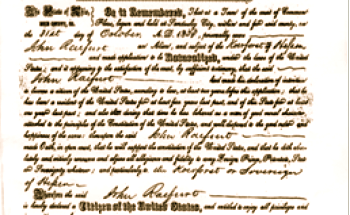Early Erie County History

The genealogy of Erie County is this: Albany, one of the original divisions of the State, 1683, gave territory to erect Montgomery County in 1772; from Montgomery was taken Ontario in 1789, embracing all the western part of the State; from Ontario came Genesee in 1802; from Genesee was taken Niagara March 22, 1808; and separating from Niagara, Erie County was erected April 2, 1821. It lies on Lake Erie and the Niagara River in the extreme western part of New York. The land area is 1,071 square miles, and the Lake Erie area 160 square miles.
Topographically, the features of the country are varied. While in general the surface is level, particularly in the north, the central part is rolling, and the southern section hilly. There are few minerals of commercial value in the county, and agriculture has become dominant and as diversified as the soils. The waters of Lake Erie modify the climate, particularly of those towns which border on it, giving them the advantage in fruit growing. The presence of Buffalo and other cities has made vegetable gardening profitable. So the farming processes of Erie are today very different from the time when the grains, particularly wheat, were the main crops of the whole area. The Niagara River, with its falls, has been the means of developing industries varied and great, not even dreamed of when the timber of the county was the main, almost only, natural resource, and the small streams entering the river or the lake, were the water powers used to drive their simple mills.
Although this region was known by the French about the time first settlements were being made on Manhattan Island, Virginia and Plymouth, and although they were the first settlers, they had little influence on the region. And after a short period under English dominion, the area came to be a part of the new American State. The lands never had the mixed titles of most districts. With the exception of the Indian Reservation and the “One Mile Strip” along the Niagara River, the entire county was included in the Holland Purchase. The Indian lands were gradually bought through a period of years.
The first settlements in the section were on the site of the present city of Buffalo about 1794-95 and shatteringly all over the county within a few years. The Holland company was very liberal in the funds spent to build roads, bridges, mills, taverns, which led to the rapid settlement of the region. But there were to be set-backs to the progress. War was declared against Britain in 1812 and the lake sections were those most open to invasion. On December 30, 1813, the British came from Canada and captured Black Rock and Buffalo, in the face of superior, but untrained American forces. The thriving village of Buffalo was burned, and Erie County was in great distress and poverty that winter. It is well to recall that at this time there were in the whole county not 4,000 people.
Immigration is a tide which has its ebb and flow, and after the end of the war an unrestrained flood of settlers entered this part of New York. In 1821 the district was too large to handle politically, even though the county seat of Niagara was at the rebuilt Buffalo, and all the southern part became the county of Erie. The great demand was for means of transportation all over the State. The roads were unsurfaced, mere cleared ways through new country. There was little intercommunication and no outlet for produce. But the Erie Canal was under way and, completed in 1825, it probably had more to do with the determination of Erie’s destiny than any other one thing. Meanwhile, on the waters on which had been launched, by La Salle I39 years before, the first white man’s vessel, a steamboat plowed the waves (August 23, 1818). This was the celebrated “Walk-in-the-Water.”
Meanwhile steam was being applied to railroads, and the first steam road in the county being the Buffalo and Niagara built in 1836. There was a railroad from Black Rock to Buffalo used in 1834, but it had the horse as its motive power. The 1850’S were a railroad building period which supplied the county with rail systems, somewhat in advance of other parts of the State, which leadership had never been lost.
By 1850 the population of the county was just over 100,000, with Buffalo a city of 42,261 and already a great grain and lumber port. Nearly three and three quarter millions of bushels of wheat were received in this year by lake; in ten years the amount had reached eighteen and a half million, and corn came in to the amount of eleven and a third million bushels. Both Buffalo and the county were extremely prosperous. The breaking out of the Civil War checked much of this; even the high years following the war not preparing it for the panic of 1873. But the natural advantages of the location of Erie County told in the end, and the despondency of 1875 left, never to return.
Railroad extension kept pace with other material growth, and coal became one of the commodities passing through the county. To care for the lake traffic, the great breakwater at Buffalo was projected in 1895. Buffalo, which had not been to any large extent an industrial city, became the home of hundreds of manufacturers. When the World War was thrust upon an unprepared nation, there were few sections in the State which so promptly switched its industries to those needed by the United States, and few sections, if we include Niagara County, did more to supply the essentials of warfare.

